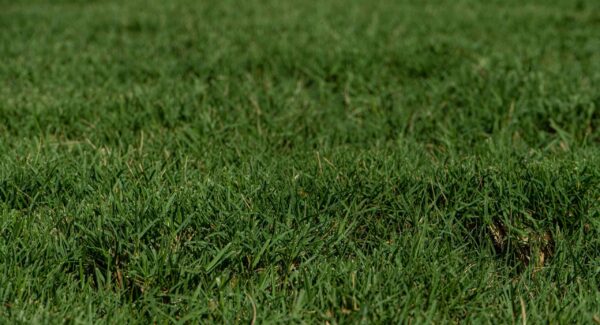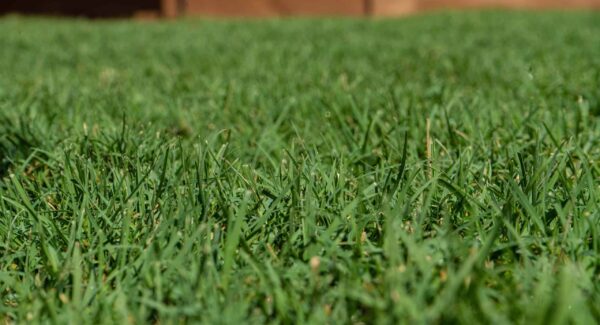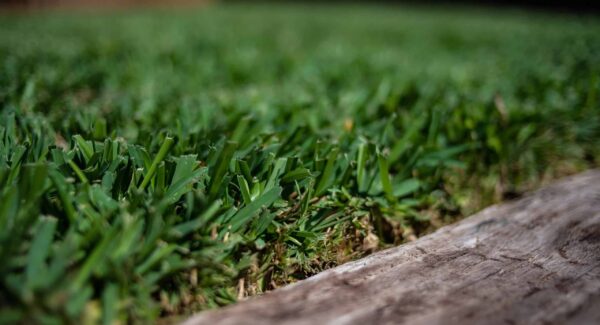Bermuda vs St. Augustine – A Thorough Comparison
Intro
When we talk about grasses for warmer regions, Bermuda and St. Augustine are among the most popular choices. We often hear whether to choose Bermuda or St. Augustine for Texas yards. Both have their pros and cons, and this text will delve into those.
By choosing grass for warmer regions, you’ll ensure they are resistant to extreme heat and dry summers and have a care schedule that doesn’t have to be demanding.
In the following lines, read about:
- The most essential characteristics of Bermuda and St. Augustine – how to identify these grass types, how they grow, what the texture of their leaves is like, and generally what their appearance is
- What kind of climatic conditions do these grasses require? How much sun do they need, and do they mind the shade?
- What kind of soil suits Bermuda and St. Augustine
- How to care for them – schedule for watering, fertilizing, and mowing.
- How resistant Bermuda and St. Augustine are to diseases and pests
Let’s get to know these types of grass better and help you take the first steps toward planting these varieties if you haven’t already done so.
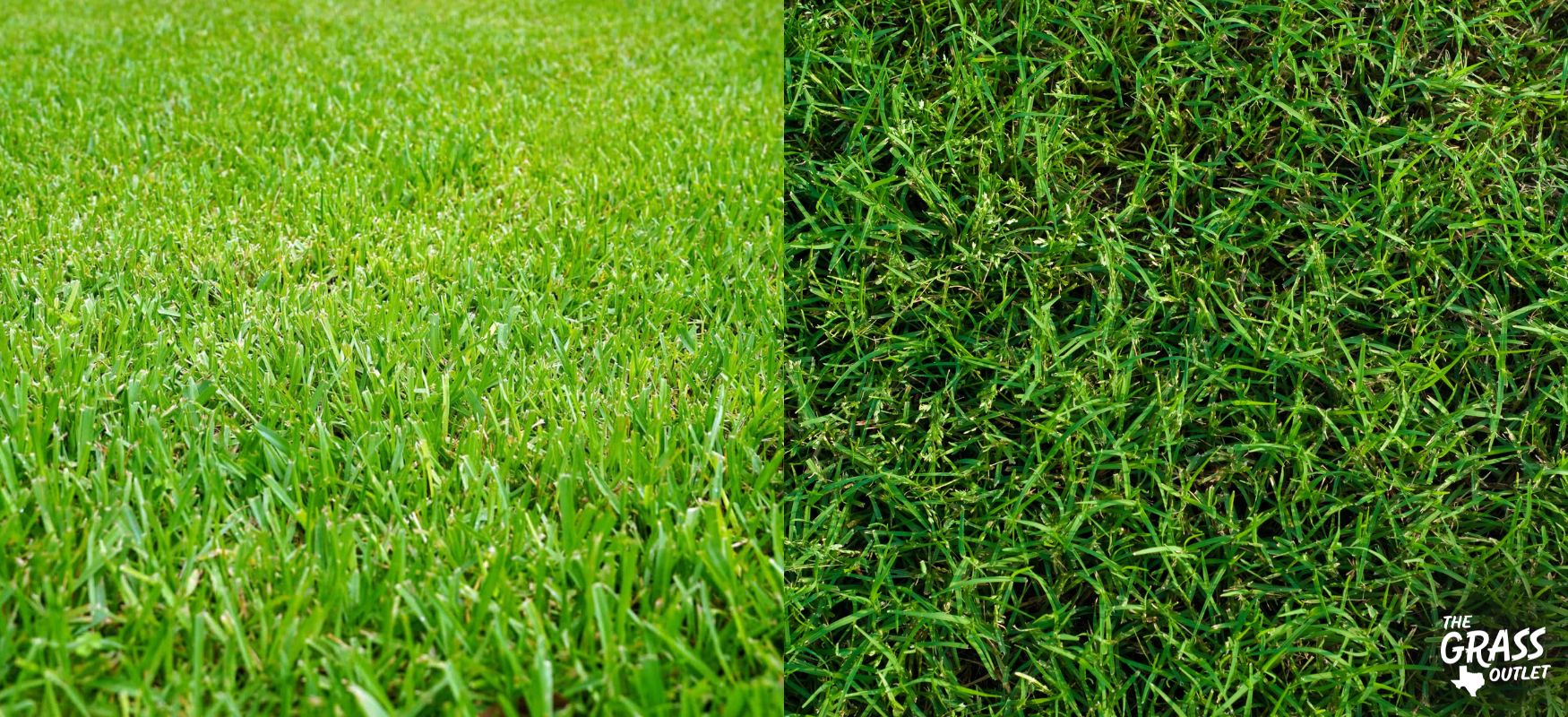
Where Do Bermuda And St. Augustine Grow Best?
Where is Bermuda grass commonly found?
Bermuda grass thrives in the southern and southeastern parts of the United States because of its warm summers and mild winters. It loves warm areas and direct sunlight, making it the most common lawn choice in southern states. Bermuda is also suitable for sports fields, as a golf courses grass, and large residential complexes, thriving best in Hardiness zones 7 to 10.
Bermuda can also withstand transition zones, i.e., climate zones where both warm-season and cool-season grasses grow well. It demonstrates its resilience in such zones.
This type of grass is found worldwide – in Europe, Africa, Asia, India, and Australia. As people migrated, they spread Bermuda to different continents. It can be considered an invasive species in many parts of the world, including the place that bears its name – Bermuda. Its adaptability to different soil types has contributed to its rapid spread and dominance in some ecosystems, including the ecosystem of Bermuda itself.
Gardening experts say that Bermuda is exceptionally durable and vital. Its robust root system helps it succeed even in the most challenging environments. Bermuda grass is remarkably adaptable, thanks to its strong roots, allowing it to survive in conditions where other grasses could not.
Where Does Saint Augustine Grass Grow Best?

St. Augustine grass, named after the city of St. Augustine in Florida, prefers warm and moist regions. Hence, it is planted in tropical and subtropical areas. Speaking about the USA, St. Augustine grass grows best in the southern belt, from South Carolina in the East to California in the West, and is often planted in the central parts of America. According to Angi.com, St. Augustine thrives best in Hardiness zones 8 to 10.
Moreover, this type of grass is also grown in the Caribbean and the Mediterranean, as it is adaptable to saline soil. You can also find it in the Gulf of Mexico, West Africa, or the West Indies.
It prefers temperatures of 80 to 95 Fahrenheit, so its growth is intense during prolonged, warm summers.
Growth Conditions Comparison
Bermuda is more tolerant of low-temperature periods than St. Augustine and quickly recovers, becoming green and lush after dormancy periods. However, St. Augustine tolerates saltier soils better, making it a better choice for coastal areas.
It is also worth mentioning that Bermuda is the first choice due to its aggressive growth when a lawn or a specific area needs quick recovery.
How to Recognize Bermuda and St. Augustine
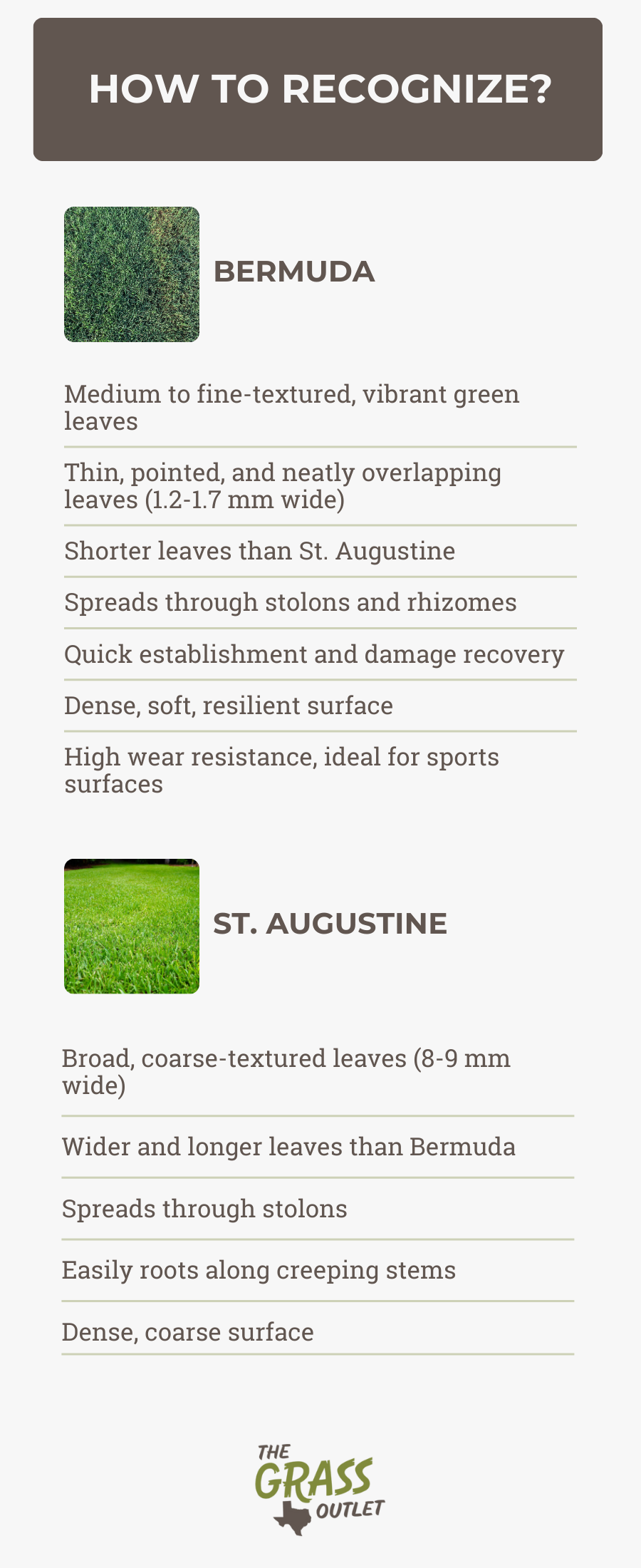
How do you identify Bermuda?
Bermuda has medium to fine-textured leaves and is known for its vibrant green color and ability to form a dense turf surface. It spreads through stolons and rhizomes, which allows it to establish quickly and recover from damage.
Bermuda’s leaves are much shorter than St. Augustine’s. They are thin and pointed, neatly overlapping each other, contributing to a soft yet resilient lawn surface. Bermuda can be used on golf courses and other sports surfaces due to its high wear resistance and rapid recovery ability. Take a look at our blog post on how to make Bermuda grass thicker.
What Does St Augustine Look Like?
As for St. Augustine grass, it has a more robust appearance. The broad leaves of this grass give it a coarse texture, making it somewhat coarseto the touch. Its growth pattern involves spreading through stolons, and this grass easily roots along its creeping stems.
St. Augustine grass leaves are wider and longer, forming a denser lawn than Bermuda. They have a slightly coarser texture compared to Bermuda, whose texture is soft and delicate. The leaves of St. Augustine are about 8-9 mm wide, while the width of Bermuda grass leaves is 1.2-1.7mm.
Ideal Climate and Soil Requirements for Bermuda and St. Augustine
Bermuda and St. Augustine varieties are warm-season grasses, meaning they thrive in sunny and hot summer conditions. It’s important to emphasize that some Bermuda varieties can grow from seeds, while St. Augustine spreads only through transplanted sod.
What Kind of Soil and Climate Does Bermuda like?
Bermuda grass prefers full sunlight and will not perform well if planted in shaded areas. It requires at least 6 to 8 hours of direct sunlight daily to maintain its beautiful green color and density. Bermuda grass tends to become sparse and patchy in areas with shade.
Bermuda requires well-drained soil. Given its preference for warmth, salt, and moisture, this grass is ideal for lawns in coastal regions. Although its root system is concentrated within the top 6 inches of the soil, it can extend to depths of 6 feet or more.
Bermuda grass tolerates both acidic and alkaline soil conditions and is highly tolerant of salinity. It thrives in the pH range of 5.8 to 7.
It starts to grow in late spring, when temperatures exceed 64°F (18°C), and continues to grow until fall. In hot regions, Bermuda can retain its intense green color throughout the year, while in areas with cooler winter months, it enters a dormancy phase.
Bermuda is very drought-resistant. Its deep root system allows it to access moisture from deeper soil layers during hot summers. Bermuda quickly recovers if damaged, making it suitable for areas with heavy foot traffic or sports competitions. Bermuda is much more drought-tolerant than St. Augustine.
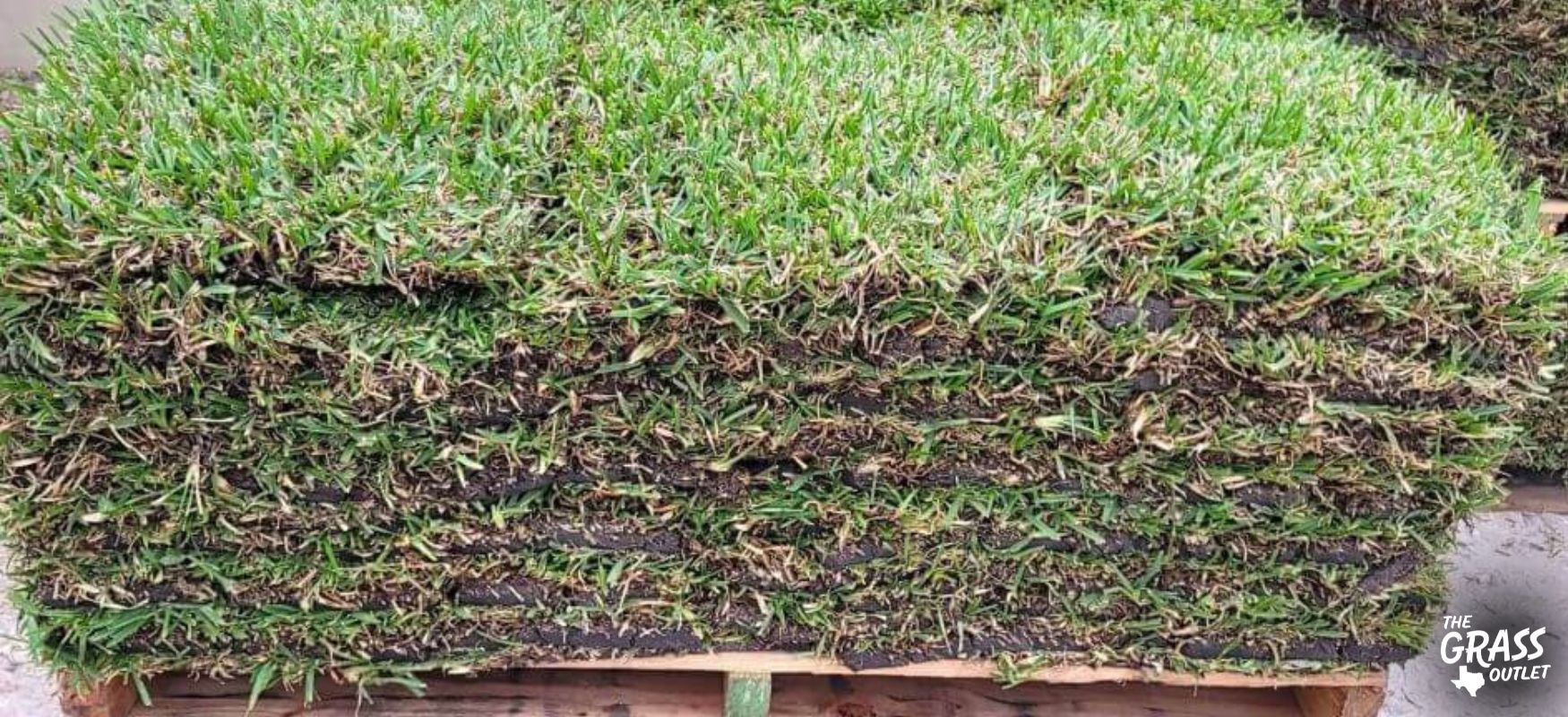
What Kind of Soil and Climate Does St. Augustine Need?
As a warm-season grass, St. Augustine thrives high in high humidity and is best suited to a temperature range of 65 to 95 degrees Fahrenheit. It tolerates salinity well, making it a frequent choice for lawns in coastal areas.
St. Augustine is type of grass that thrives in sandy soil or loamy soils and can succeed in various soil types with a pH range of 5.0 to 8.5. Like Bermuda, good drainage is crucial for St. Augustine.
It does well in full sun and partially shaded lawn areas, which is an advantage over Bermuda. In terms of shade tolerance among warm-season grasses, it performs the best. It can withstand drought for a certain period, but it will go dormant during extended drought conditions, and without water intervention, it can be damaged.
Experts advise planting St. Augustine in spring and fall when temperatures are warmer but not yet extremely hot; however, planting during winter brings an added perk of reduced watering requirements.
St. Augustine can remain green throughout the year only if the soil temperature does not fall below 60°F during colder months and receives proper water during warmer months. If it changes color due to low temperatures, it’s merely a sign that it’s in a dormant phase, but it will regain its color as soon as temperatures rise.
Grass Varieties Maintenance Needs
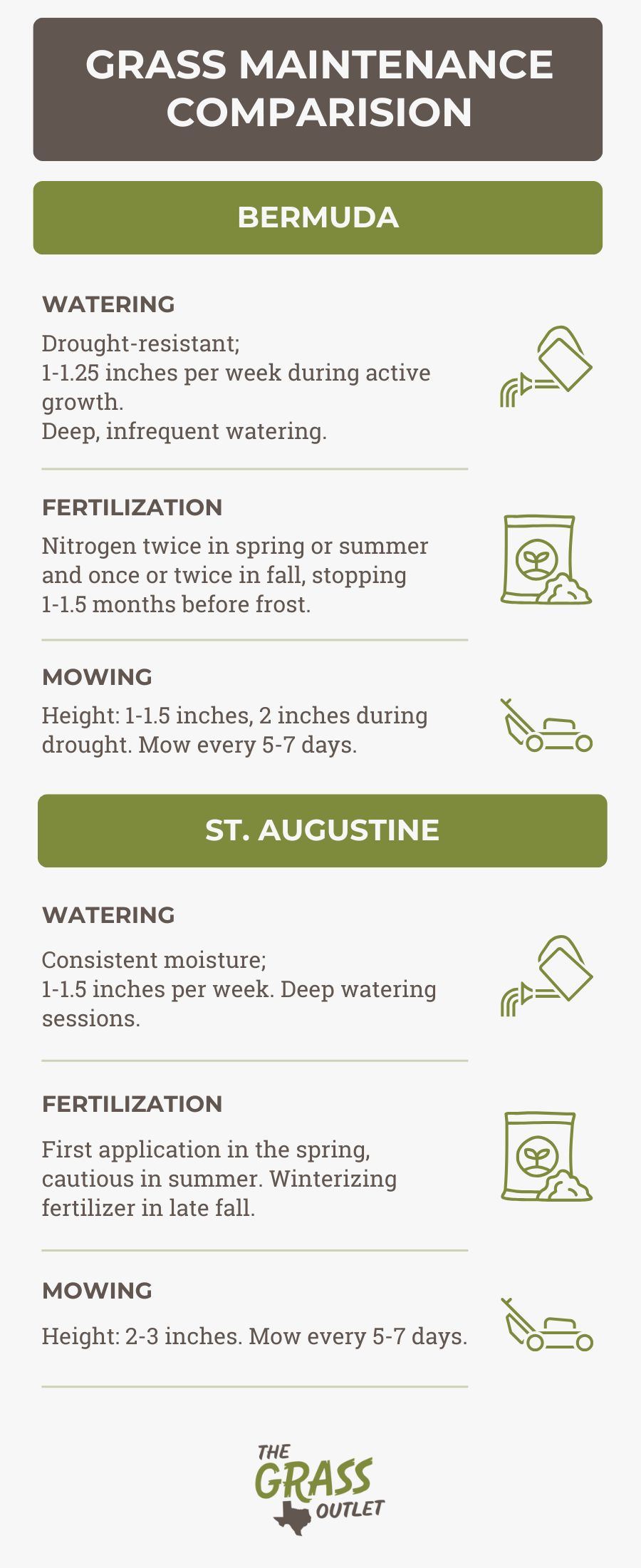
Establishing certain care practices is necessary to keep a lawn healthy and neat, and Bermuda and St. Augustine have different needs.
Bermuda Grass Maintenance
- Watering needs: Bermuda is known for its drought resistance. It can survive on less water compared to many other types of grass. However, regular watering is recommended for optimal growth and a lush, green appearance.
- Frequency and amount of watering: During the active growth season (spring and summer), Bermuda grass typically requires about 1 to 1.25 inches of water per week from rain or irrigation. It’s important to water deeply and infrequently, rather than often and shallowly, to encourage grass sod to take deep root.
- Fertilization: Bermuda is a nitrogen lover. Depending on your soil health, you should fertilize twice in spring or early summer when the grass begins its active growth and once or twice in the fall. The last fertilization session should be about a month to a month and a half before the first frost.
- Mowing: Bermuda’s ideal height is between 1 and 1.5 inches. During the active growth season, it is recommended that Bermuda be mowed every 5 to 7 days or often enough to maintain the recommended mow height. On days of extreme drought, it should be mowed to a height of 2 inches.
St. Augustine Grass Maintenance
- Watering needs: St. Augustine grass requires more consistent moisture than Bermuda grass to maintain its health and lush appearance. It’s less drought-tolerant and will show signs of stress in dry conditions more quickly.
- Frequency and amount of watering: St. Augustine grass needs about 1 to 1.5 inches of water per week during the growing season. Like Bermuda, this should be applied through deep watering sessions rather than frequent light watering. This approach encourages the development of deeper root systems and improves drought resistance.
- Fertilization: You should fertilize St. Augustine for the first time when it turns fully green in spring. Use extreme caution when fertilizing during the summer. Apply a winterizing fertilizer in the late fall.
- Mowing: A mowing height between 2 and 3 inches is ideal for St. Augustine. When it’s actively growing in spring and summer, you can mow every 5 to 7 days or often enough to maintain the recommended mow height.
General Watering Tips
- Water early in the morning: Early morning is the best time to water your lawn, reducing evaporation and ensuring the grass has enough moisture throughout the day. Watering in the evening or overnight can introduce fungal lawn diseases
- Monitor the soil and grass: Pay attention to the soil moisture and signs from your grass. Wilting, a bluish-gray color, and footprints on the grass long after being made indicate it’s time to water.
- Adjust for rain: If significant rainfall occurs, adjust your watering schedule to avoid overwatering and potential fungal growth, especially in high-shade areas.
Bermuda grass is more resistant to wear and injury than St. Augustine grass. This is why Bermuda is more commonly used for sports fields or areas with heavy foot traffic, such as certain residential complexes.
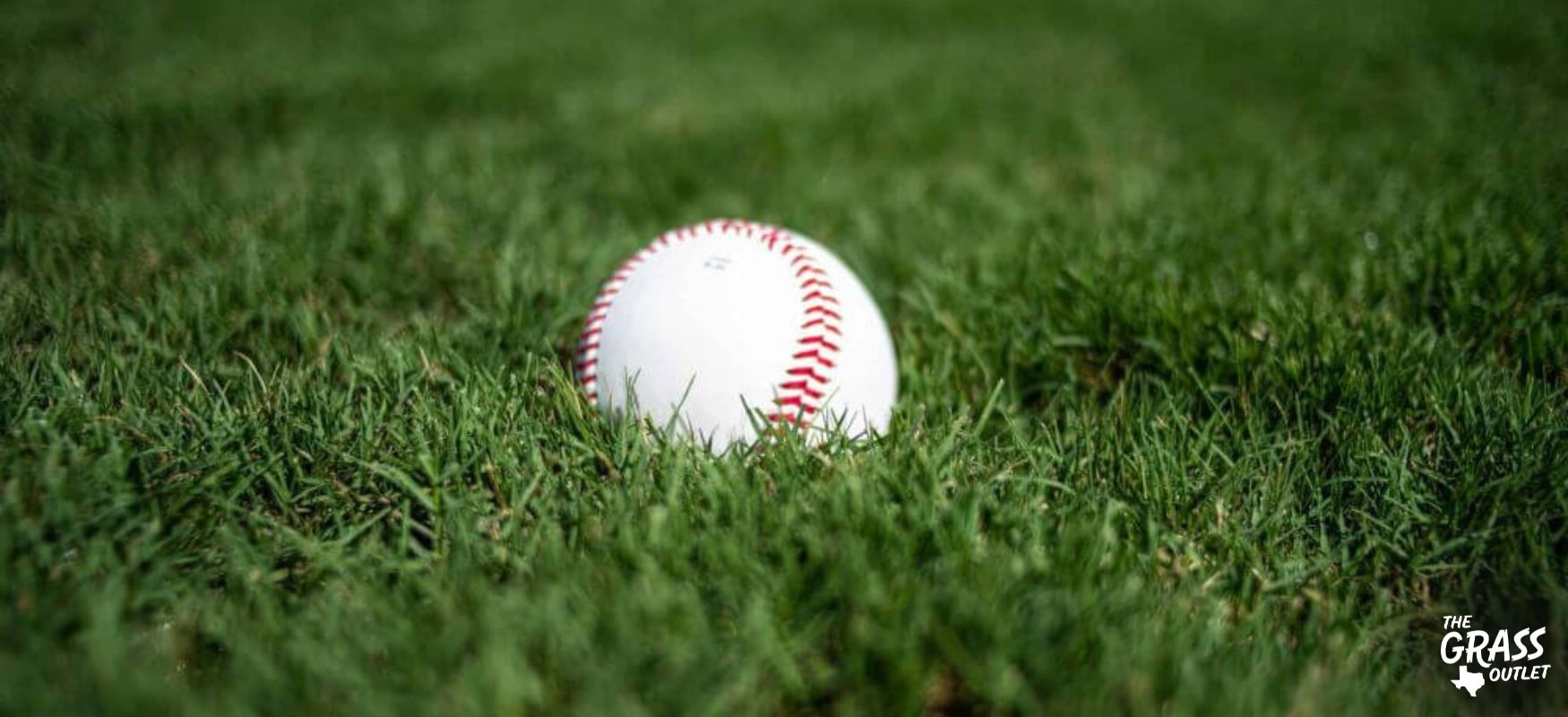
How Resistant Are Bermuda And St. Augustine To Pests And Diseases?
Both grass types are susceptible to pests such as chinch bugs, grub worms, sod webworms, and fall armyworms, but Bermuda also faces attacks from grass mites and billbugs, making it more vulnerable in this aspect compared to St. Augustine.
Regarding diseases, the fungus Rhizoctonia solani — also called Brown Patch — can cause significant, circular brown patches on Bermuda grass, especially during spring and fall following hot, rainy weather. The Spring Dead Spot disease also creates circular patches of dead grass that appear as the lawn greens up in spring, especially following prolonged droughts and freezing temperatures. Dollar Spot and Pythium equally threaten Bermuda.
Grey leaf spot, downy mildew, and brown patch are the most common diseases of St. Augustine grass. Over and under-fertilization, low-quality sunlight, and high humidity can also cause brown patches and thinning. Therefore, focus on good drainage and tree maintenance is essential.
Advantages and Disadvantages of Choosing Bermuda Grass for Your Lawn
- Drought Tolerance: Bermuda grass is highly drought-tolerant, making it ideal for areas experiencing hot, dry conditions. Compared to many other grass types, it requires less water to maintain its health and appearance.
- High Wear Resistance: Bermuda grass is an excellent choice for high-traffic areas. Due to its rapid growth rate and dense turf formation, it recovers quickly from damage.
- Sun Loving: Bermuda grass thrives in full sun. It’s perfect for open landscapes where it can receive 6 to 8 hours of direct sunlight daily.
- Low Disease Susceptibility: While no grass is immune to all diseases, Bermuda grass tends to have fewer problems with pests and diseases than other turf types.
- Aesthetic Appeal: Bermuda grass’s fine texture and deep green color can create a beautiful, manicured look for any lawn.
- Heat Tolerance: It can withstand high temperatures, making it an excellent choice for southern regions with particularly harsh summers.
- Shade Intolerance: Bermuda grass requires a lot of sunlight and does not perform well in shaded areas. Bermuda might struggle to grow if your lawn has many trees or structures that create shade.
- Cold Sensitivity: It is not very tolerant of cold weather and can go dormant and turn brown at the first sign of frost, which might not be ideal for regions with colder climates.
Pros and Cons of Choosing St. Augustine Grass for Your Lawn
- Shade Tolerance: St. Augustine grass is one of the most shade-tolerant warm-season grasses. It can thrive in areas with moderate shade, where other types of grass might struggle to grow.
- Good Disease and Pest Resistance: Although susceptible to certain pests and diseases, St. Augustine grass can withstand them better than Bermuda, given proper care and maintenance.
- Drought Resistance: While it does require more water than Bermuda grass, St. Augustine is relatively drought-resistant once established. It can survive dry spells with minimal watering.
- Salt Tolerance: It tolerates coastal conditions, including salt spray, making it an excellent choice for lawns near the ocean.
- Cost: St. Augustine grass is often more expensive to install than Bermuda grass because it is usually established from sod or plugs rather than seed, which can increase the initial cost of landscaping.
- Wear Tolerance: It has a lower wear tolerance than Bermuda grass, making it less ideal for high-traffic areas or lawns used for activities.
- Maintenance: St. Augustine grass requires regular maintenance, including frequent mowing, watering, and fertilization, to keep it healthy and looking its best. However, with its height recommended mow height, you’ll mow it less frequently than Bermuda.
- Water Requirements: St. Augustine grass typically requires more water than Bermuda grass.
Conclusion
Certainly, before choosing a specific type of grass, it’s important to consider conditions such as the amount of sun and shade in your yard and what level of care you can provide for lawn maintenance and upkeep.
As you have seen, both grass types have advantages and disadvantages, making them a good choice for different states and climatic conditions. It is essential to adapt the grass to the existing climatic conditions, as this will require less effort to keep it looking healthy and tidy.
If you have any doubts about St. Augustine and Bermuda, contact The Grass Outlet. Our experts will gladly assist you in making a choice.
